
Council, Politics & Public Services - Local government 1814-1830s
The town's first inhabitants had little say in local and national government. Reform acts though the
nineteenth century, and in the twentieth, ensured that an increasing number of electors could
vote for representatives in both local and national government.
The early townspeople had to fend for themselves in providing essential services such as water
supply and street lighting. As the nineteenth century progressed, the council took some
responsibility for these and other matters.
Although the 1818 Act permitted regulations for street paving and lighting, Pembroke Dock in the
1830s was still a place "not in any part lighted [or] paved". In the 1820s "the people of the town
acted for themselves in all municipal matters". When spring water overflowed into the street, for
example, the townspeople simply "made a drain, the first in the town". On unpaved streets, "every
female, when out of doors, wore patterns or clogs to keep their feet clear of mud".
For street lighting, "every house was provided with a few lanterns for use during the dark winter
nights, for walking through the streets and bye-ways ... On a dark Sunday night it was something to be remembered to
have seen the numerous lights bobbing about in the hands of people coming from places of worship".
Walking home was hazardous after 10pm, when candles in windows were extinguished. Heating fuel was culm, a
mixture of mud and coal - of which householders left heaps in the streets overnight. Mason recounts the fate of one
late stroller who, "without the aid of a lantern, walked into the middle of a heap of slime... he was terribly annoyed".
Equally unsettling was the possibility of blundering into one of the donkeys who slept in the darkened streets near
Albion Square - one lady was "frightened into a fit by the loud, sudden and unexpected music".
Various organizations could provide local services. Until the 1830s, it is not entirely clear who is responsible for the
needs of the new settlement. The town had been established around the Royal Dockyard, and was soon developing on
private land. Municipal affairs in the nearby borough of Pembroke had since Medieval times been run by the
Corporation of Pembroke - with whose mayors (as spokesmen for both the borough and the parish) the Navy Board
deals before the 1830s.
By Mason's account, the road from Pembroke to Pater needed improvement in 1816, for extra Dockyard traffic. The
Mayor of Pembroke, Mr Humphreys, persuaded the Navy Board to contribute " £ 200 to the road authorities". The
improved road, it was agreed, would then be maintained by the parish. The 1818 Act of Parliament authorised the Navy
Board to "establish a market at the town of Pembroke Dock", but the new Mayor - Mr Stokes - intervened. This
proposal, he protested, infringed the ancient rights of Pembroke Corporation's market. Considerable negotiation and £
3,000 compensation were required before, in 1826, the Pembroke Dock market could open.
(Sources: Act; Mason 38-42, 78-9, Hogg, Lost PD; Peters 32, 122, 41; Gibbs)
Pictures by courtesy of: Pater ward map, Mr Michael Blake (cartographer: Lt R.K. Dawson) - PBC coat of Arms, Pembroke Dock Museum Trust.
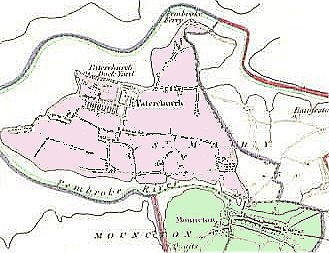
Pater ward, Pembroke Borough,1837 (pink).
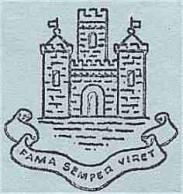
Pembroke Borough coat of arms

Council, Politics & Public Services - Local government 1830s - present
Mr John Hogg quotes the 1837 Boundary Commission - the town is still "not in any part lighted [or] paved nor is any rate levied by the Corporation". However, boundary
changes and other reforms gradually took effect after the 1835 Municipal Corporation Act. These ensured that Pembroke Dock, like other new industrial towns,
received more local government attention.
Pembroke Borough was given two wards, Pembroke (the old town) and Pater (Pembroke Dock). Each elected its own representatives to the Borough Council, which
came to employ officials and could buy in some services from commercial companies.
The first gas street lights were paid for by groups of householders. The Council decided in 1854 that Pembroke St and Commercial Row should have gas lighting. The
council contracted the town's private gas company to supply lighting for these and other streets. Later nineteenth century pictures show lamp standards, and streets
finally paved.
After the Corporation bought the Market in 1881, its buildings were used for council business. "Town council deliberations" were for a time conducted in the Council
Chamber there. Council offices were also established in Bush Street.
By the 1900s, council committees attended to sanitation, water, gas, buildings and works, the market and highways - a steam roller was available for work on
highways . Borough Council officials included the Town Clerk, the Surveyor and the traditional Town Crier. The posts of Medical Officer of Health and Sanitary
Inspector reflect increasing concern for public health, as do the improved water supply and sewerage system (c. 1900-) - parts of Pembroke Dock had suffered
epidemics of cholera and smallpox in the 1850s and 60s.
The first mayor from Pembroke Dock (1843) was Edward Laws, a senior Dockyard official and Naval Storekeeper. Increasingly after the 1870s, mayors come from Pater,
as well as Pembroke, ward. Mayoral duties, in Dockyard times, included welcoming Royal visitors to the Dockyard and proclaiming new monarchs in Albion Square.
Mayors also attended the town's numerous parades and civic ceremonies.
These mayors' concerns and interests often go beyond their council responsibilities. William Seccombe (1888-9) paid for seats to be provided on the Barrack Hill.
Samuel J. Allen, the photographer, (1896) was "chiefly instrumental in founding the Nurses' Home and Meyrick Wards" in Park Street (not then a public service, and
helped by donations and gifts). Samuel Sketch (1893) "was the first councillor to take up the improvements of the Pennar roads". John C. Froyne (1897) of Pembroke
was an outstanding chief constructor in the Dockyard. He was responsible for "a new illuminated clock" in Pembroke clock tower. William Davies (1898) introduced an
improved water supply and encouraged tree planting in Commercial Row. James Hutchings (1902), was praised for "getting a certain number of gas lamps lighted all
night in the- streets". Angus McColl (1901) lent his engineering expertise to "the introduction and development of the complete and adequate water supply to the town
from Milton".
The establishment of Pembrokeshire County Council, after 1888, created a new level of local administration. James Hutchings had smoothed dealings between the
Borough Council and the new County Council . This "required a good deal of tact and entailed much labour". He went on to become Mayor of Pembroke Borough in
1902. Pembroke Dock was represented by up to six County Councillors. Cllr. William Smith, in the 1920s, was particularly respected for his interest in education and
libraries
Pembroke Borough Council operated alongside Pembrokeshire County Council until 1974, when the County Council was replaced by Dyfed County Council and South
Pembrokeshire District Council, whose offices were in the old Llanion Barracks. These bodies were, in turn, superseded in 1996 by Pembrokeshire County Council (mark
2), beside which the smaller town councils of Pembroke and Pembroke Dock now function.
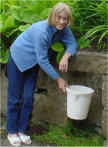
In Victorian times, the "hole in the wall" provided water, not cash. By 1861, water
from the spring at the top of Park Street came through a tap. The safe housing around
the well had been paid for by public collection. Around 1900, the council's Water
Committee placed "hydrants .. in convenient parts of the streets", fed by pipes from
reservoirs.
(Hogg, Lost PD, Peters 32, 49-50)

Local councillor revives Pembroke Dock's aviation industry.
Cllr Brian Hall's Sunderland, by courtesy of Martin Cavaney Photography.
Cllr Brian Hall and his friends were disappointed that no real Sunderland flying boat could appear at the
1990 theme week.
So they constructed this fine, almost life-size, model.
(Sources: Mason 103-11; Peters 42, 47-50,122-129; Pem RO PEM/SE/2/4) Pictures by courtesy of: Water supply, Mrs Lynne Gibbs - Cllr Brian Hall's Sunderland, Martin Cavaney Photography.

Council, Politics & Public Services -
Parliament
In the early nineteenth century, the small number of men qualified to vote would elect candidates who often came from landowning families. "Reform" - giving
more people the right to vote - was in the air during the 1831 election. Locally, though, the fifteen-day hustings were conducted along traditional lines.
The Pembrokeshire candidates were Sir John Owen of Orielton and Colonel Greville of Milford. They entertained their supporters in numerous Haverfordwest pubs,
and Each was backed by a strong-arm gang. George Mason notes "the deep and lively interest taken ... by Dockyardmen. Tales of the yeoman work done by both
sides in eating, drinking and fighting (were remembered thirty years later) ... Some enormous achievements by the aid of fists were reported to the credit of
noted Dockyardmen... It is said that the opponents nearly ruined themselves over the expenses of this contest".
The 1868 Pembroke Boroughs candidates were Sir Hugh Owen (Liberal), and Thomas Meyrick of Bush (Conservative). The election was conducted in slightly more
restrained style. "Party feeling ran very high ... Demonstrations and torchlight processions took place nightly as the decisive day drew near, and ... opposing
parties oftentimes met on the route and the exchange of words, and sometimes of blows, may be ... imagined".
By 1868, most householders in towns were entitled to vote. After 1872 they were allowed to vote in secret, rather than by publicly announcing their choice.
The winner by a narrow margin of 1874 Pembroke election was not, like many candidates up to that time, a local landowner. Mr (later Sir) Edward Reed had been
Chief Constructor at the Admiralty. An M.P. with obvious expertise and authority for a shipbuilding constituency, he went on to develop the private dockyard at
Jacob's Pill.
In Parliament, Reed robustly promoted the interests of the Dockyard and its workers - as did his successors. Between 1886 and 1926, as Roland Thorne notes, a
series of Liberal and Conservative MPs spoke up for the interests of Dockyard workers (pensions and better promotion prospects, more apprentices , a minimum
wage for hired employees, the case to re-employ men laid off laid off after major projects), and for the yard itself (a dry dock, better lifting equipment, more
slipways, a graving dock and completion of the Carr Jetty).
In the twentieth century, the Labour Party became a force to challenge the Liberals and Conservatives. The threat to close the Dockyard, to "scrap a town and its
population", eclipsed party differences. Conservative MP Major Price and Labour Councillor Edgar Harries both argued Pembroke Dock's case face to face with
Stanley Baldwin, the Prime Minister.
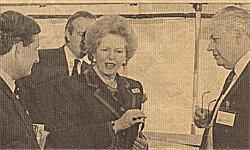
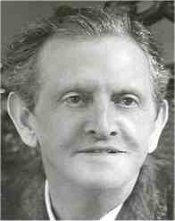
Major Gwilym Lloyd George was the Pembrokeshire's last Liberal MP (1929-
1950). Since 1950, the county's MPs have been Conservative and Labour.
Desmond Donnelly (MP 1950-1970) is remembered as a politician
conscientious in serving his constituents but increasingly at odds with his
party, Labour. He finally stood as an independent "Democrat". The
Pembroke Dock Labour Party stayed committed to the government - the
branch's chairman, Cllr Cledwyn Nicholls, was highly respected and an
elder statesman in local politics. In the 1974 election, the Labour vote was
split between Donnelly and the official party candidate, the late Lord
Gordon Parry. This helped Nicholas Edwards, the winning Conservative
candidate.
In 2006, the area's Westminster MP Nick Ainger, and Welsh Assembly AM
Christine Gwyther both represent the Labour Party. Both have their homes
in Pembroke Dock

Council, Politics & Public Services
Healthcare
Healthcare - and safety - have progressed since the eighteen-fifties - the times of the mysterious "doctoress of
Llanreath" , who possibly dispensed traditional remedies, and the unfortunate Dr. Sumpter. Walking back from a
visit to Pennar one night, Dr. Sumpter slipped in the dark and fell to his death in the Defensible Barracks moat.
The first hospitals for injured workers were converted ships moored offshore - HMS Saturn then, from 1867 to
1895, HMS Nankin. The Meyrick Wards, later the Meyrick Hospital, were built to mark Queen Victoria's diamond
jubilee in 1897-8, formally opened in 1899 and served until the 1950s. The Meyrick Flats now occupy the site.
The Royal Naval Hospital at Fort Road, now developed into the South Pembrokeshire Hospital, was constructed
around 1902. After the closure of Jacob's Pill private dockyard, the mould loft provided as an isolation hospital
for patients with infectious diseases, between approximately 1890 and 1940.
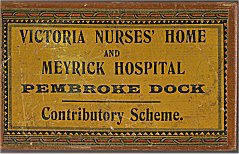
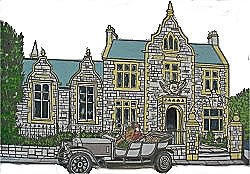
Before the National Health Service
, donations in a collection box
helped fund the Meyrick Hospital.
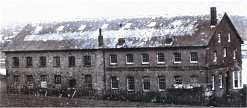
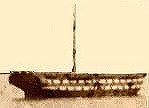
Jacob's Pill Isolation hospital.
HMS Nankin
(Sources: Peters 69-70, 72; Carradice 64; Rose, R. 412-4.)
Pictures by courtesy of: Collection box, Pembroke Dock Museum Trust - Meyrick Hospital, Mr George Lewis & The Coronation Centre - Isolation hospital, Mr Bryn Rixon.

TOP
HOME
(Amendment, updates and additions) (AJ) Anndra Johnstone
This site is designed, published and hosted by CatsWebCom Community Services © 2018 part of Pembroke Dock Web Project
































